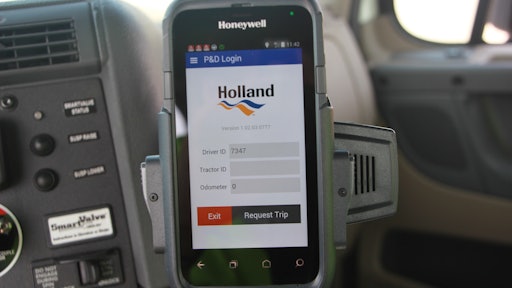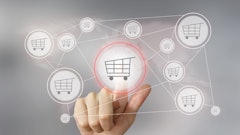
Just about every consumer good sitting on a shelf or in a warehouse finds its way to its final destination via truck. In fact, the American Trucking Associations (ATA) reports that trucks accounted for 70.1 percent of domestic freight tonnage in 2015. Trucks deliver products quickly and efficiently, and in the tight timeframes consumers have come to expect.
Now, the ATA is predicting that the amount of freight moved by trucks will jump by 27 percent between 2016 and 2027. Meanwhile, America’s supply of drivers continues to dwindle and the ATA estimates the industry will need more than 96,000 new drivers over the next decade to keep pace.
In order to stay competitive in this fast-paced logistics world, trucking companies need tools to drive efficiency and meet heightened consumer demands.
Holland, a regional less-than-truckload (LTL) transportation provider offering one- and two-day service in the Midwest, southeastern United States and eastern Canadian provinces, made strides to address these issues when it partnered with Honeywell to add a solution that improves customer care and driver satisfaction.
The company found its answer in the Honeywell Pickup and Delivery Solution. This Android-based software runs on a Honeywell Dolphin CT50 mobile computer, and allows the company’s 3,000 pick up and delivery drivers to easily navigate through their workday, communicate with dispatch and update shipment status in real time. Drivers can also scan labels and take pictures of shipments when necessary. It is a complete managed service that includes hardware and software.
This solution replaces Holland’s existing system, which was difficult and time consuming to use, according to Chris Heslop, senior marketing manager at Honeywell. “Drivers had to perform multiple steps to carry out a core task, like freight delivery or pick up information. And, it wasn’t always presented in an intuitive way; drivers had to go through many steps to get the information,” he says.
Real-time Records
Scott Ware, president of Holland, points out that Holland began exploring in-cab technology a few years ago, and sought a platform that would adapt to many different applications and future changes down the road. Honeywell’s technology fits the bill. Its platform helps the LTL carrier meet Department of Transportation and Federal Motor Carrier Safety Administration regulations.
Says Ware, “From a compliance standpoint, we’ll be able to turn this system into an Electronic Logging Device (ELD), so that information will be readily available if a driver is at a weight inspection station, and they’re checking hours of service. The driver will be less likely to encounter delays because he or she is waiting for information to be transmitted from another source. With this sytem, Holland will be well ahead of the federal mandate required for ELDs at the end of 2017. This is another way that Holland is driving technology for the benefit of our customers and our company alike.”
Dispatchers benefit as well. The Honeywell Pickup and Delivery Solution integrates a mobile app for drivers that ties directly into Holland’s dispatch system. The system gives dispatchers real-time visibility into driver and shipment status, allowing them to offer assistance if necessary. The app provides information on things like “the status of deliveries for customers. Are they on schedule? Are they behind? Is rerouting necessary? Dispatchers can now manage a larger number of drivers on the road at any one time,” says Heslop.
The app also improves driver efficiency because it intuitively guides drivers through the pickup and delivery process, and provides immediate access to information to help drivers better accommodate customer requests.
Driver Experience
Ware predicts the new technology will help Holland in its quest to attract a new generation of young drivers, who will like what the platform offers inside and outside of the cab. Ease of use and an alignment with the newest mobile technology are crucial for Holland driver recruitment efforts, Ware says, noting that the company has recently launched a campaign to attract millennials, who are drawn to innovative companies.
“Millennials have used this type of technology in their personal lives, and want access to it in their professional lives as well,” he says. “The CT50 is basically a smartphone device that allows them to utilize the application in a mobile environment. We are set to attract a new generation of young drivers with best-in-class technology that will make their jobs easier.”
Drivers also appreciate that it is an intuitive system to use. They simply follow a series of prompts after they log in and they are ready to go. Drivers enter a personal ID, then the tractor’s ID, confirm the odometer setting and request the trip, then all information integrates with Holland’s back-end system as they move throughout their day. Workflows built into the software guide drivers through their day, detailing which deliveries need to be made and listing what needs to be picked up. At deliveries, drivers just deliver the product, scan in the details, get back in their cabs and move on to the next delivery.
“By integrating the new Honeywell Pickup and Delivery Solution, Holland gains better operational intelligence providing a more satisfying and consistent experience to their customers,” says John Waldron, president and CEO, Honeywell Safety and Productivity Solutions. “With this software guiding drivers through each step of the pickup and delivery process, we can help Holland reduce the time needed to onboard new drivers while speeding communication of the time-sensitive shipment information needed for next-day delivery operations.”
The mobile nature of the technology also aids in the latency problems drivers were experiencing, says Ware. “This was creating delays for our drivers who were spending a lot of time inputting their information. It was taking a long time for them to connect and to get the system to accept the information, even our communication back to them was delayed in certain areas where they lacked connectivity. We haven’t run into any of these problems since we added this technology. Our connectivity is nearly 100 percent throughout the day.”
By the Numbers:
70.1 percent - Of domestic freight tonnagewas delivered by trucks in 2015.
27 percent - Predicted increase in truck freight by 2027.
96,000 - Drivers needed over the next decade to cover freight increases.
--Source: American Trucking Associations



























